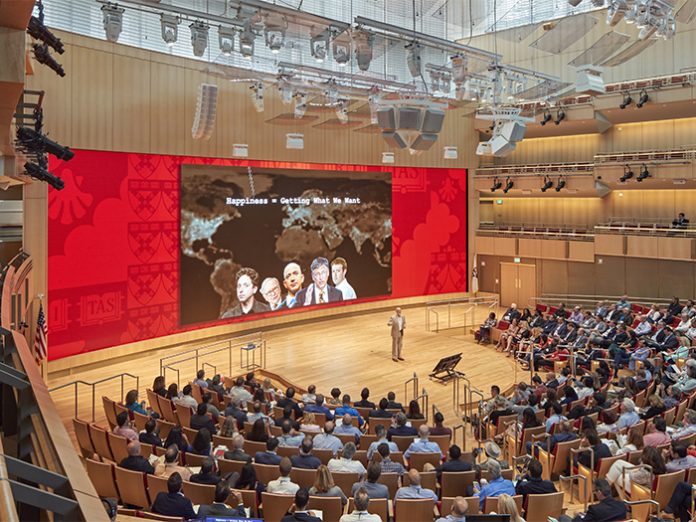
Harvard Business School opened a state-of-the-art multipurpose auditorium at its Klarman Hall campus in Allston, Massachusetts. With an emphasis on sustainability and technological innovation, this 61.8-foot-wide curved display serves the many uses of the auditorium in innovative ways.
Klarman Hall, designed by William Rawn Associates, Architects, Inc. and made possible by a gift from Beth and Seth Klarman (MBA 1982), seats up to 1000 people across three tiers, providing an inspiring space for large scale events. An innovative floor plan allows it to be set up for smaller-scale events as well. The focal point of the auditorium is a 116 square meter digital canvas from fine pixel pitch display innovators SiliconCore Technology. Specifying a 1.9mm pixel pitch, the 18.8-meter-wide by 6.2-meter-high (61.8 by 20.2 feet) LED display is built onto a custom frame from mounting specialists RP Visual Solutions. In order to accommodate viewing distances ranging from 5 to 40 meters, the display has been designed with a subtle curve to optimize viewing angles.
Global integrators, AVI-SPL, who oversaw the project alongside Idibri (AV design engineer), installed an audio system of ultra-sensitive microphones and more than 100 speakers to create a uniform sound across the auditorium. A complex wireless network includes 80 wireless Ethernet access points, 32 antennas in the auditorium ceiling, and multigigabit Ethernet uplinks throughout the building. The second story and lower-level concourse feature studios to support podcasts, webinars, online learning and a black box room for videotaping the HBS digital learning platform, HBX.
The digital display also had to meet stringent audible noise emission and sustainability requirements set by Harvard Business School. Advanced testing conducted by SiliconCore engineers ensured no audible noise generated by the LED screen would be detected by the ultra-sensitive microphones located close to the screen. SiliconCore’s proprietary Common Cathode technology, which has a significant effect on the operating temperatures and power consumption of the display was pivotal in meeting this requirement. Along with the audible noise reduction, this proprietary technology prolongs the display’s lifespan, increases brightness and reduces the power requirements by up to 40%, leading to lower operating costs.




